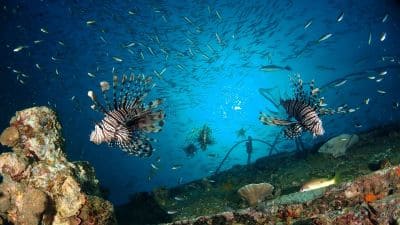Home › Top Dive Sites › Asia › Thailand › Khao Lak › Boonsung Wreck
Scuba Diving the Boonsung Wreckage
Even though the sunken remains are a popular diving destination for Khao Lak daytrips, they often combine it with liveaboards going to the Similans.
This guide explains everything divers need to know about the Boonsung Wreck dive site, including how it sank, the average depths, and what kind of marine species inhabits the rusty ruins.
Where is the Best Wreck Dive in Khao Lak?
Thailand's Andaman Sea coastline was a global hub for the tin industry during the early 20th century.
Yet, all small dredging vessels had to battle with rough seas during the monsoon seasons.
The Boonsung Wreck was a sixty metre tin dredger used in the 1950s. But, it sank in 1984 about twelve (12) nautical miles from Thap Lamu pier.
She now rests on the flat dark brown sand of the seabed around seven (7) nautical miles (12km) west of Khao Lak scuba diving hub.
The tin mining vessel was still intact when it first hit the bottom of the sea around nineteen (19) metres below the surface. But, the Thai navy had to level out the wreckage because it had become a shipping hazard.
Thailand's worst natural disaster was the Asian tsunami 26th December 2004. As a result, the 'harbor wave' added further damage to the Boonsung boat and broke into several large pieces strewn around the sea floor.
Fun Fact: Some of the diving industry news stories and archives suggest that the Boonsung Wreck (also known as the Bangsak Wreck) sank due to a flooded toilet. We are unable to prove or disprove this interesting suggestion at this time.
An Underwater Magnet for Marine Life
There's no shortage of marine species you can find living around the submerged, decaying, metal structures. Even so, some of the most notable sea life creatures found at this dive site of an old dredging vessel, include:
 Barracuda
Barracuda- Frogfish
- Honeycomb moray eels
- Juvenile fusiliers (Caesionidae)
- Lionfish
- Nudibranchs
- Porcupinefish
- Scorpionfishes
- Seahorses
Another striking feature is how the coral has encrusted many of the broken structures. In fact, local divers placed some artificial reef objects at the site (e.g. concrete statues of a dolphin and a toilet). The arrangements seem to attract schooling fish, such as trevally, orbicular batfish, and yellow snappers.
What about Sharks and Rays?
Large swathes of sand and silt create natural habitats for a range of shark species and rays. So, look around the seabed and you should see:
- Leopard sharks
- Marble rays
- Stingrays (Myliobatoidei)
Note: Don't forget to look 'up' occasionally too! It's not uncommon to see a mighty whale shark swimming above the Boonsung dive site (e.g. February to April).
Underwater Hazards at the Boonsung Wreck
In general, the water currents that flow through the dive site are relatively mild. The visibility can range anywhere between five (5) metres near the surface and twenty five (25) metres at the bottom.
As a result, descending on one of the fixed buoy lines is the best way to reach the site - especially new divers. On most dives, you're unlikely to see the wreck layout until you get below ten metres.
The shallowest point is about fourteen (14) metres. Thus, some of the local dive shops based in Khao Lak choose to conduct dive four of the Open Water course at this location.
This part is important:
Other than a fixed ascent line, there are no shallower reference points between 14 metres and the surface. Hence, always be aware of your no decompression limits because the normal multilevel diver profiles are slightly 'skewed' here.
Divers with a wreck diving certification will already know that sharp rusty metal is an obvious hazard. Nonetheless, diving the Boonsung vessel has several other dangers to be aware of, including:
Despite calling the Boonsung dive site a 'wreck', as a matter of fact it's not a ship. Thus, there is no bridge, hull, or internal cabins. Wreck penetration should only be conducted by trained wreck divers who are using the appropriate safety equipment.
Other Wrecks in the Area
The Boonsung Wreck is not the only tin mining vessel in the area. There is another small craft called the Premchai Wreck that went down nearby in 2001 and the Thai Muang Wreck - resting in murky water.
Related Information and Help Guides
- Artificial Reef Dive Site Khao Lak (Underwater Museum)
- Pattaya Wreck Diving Information for Beginners
- List of Khao Lak Dive Sites
- Best Shipwreck Diving Sites in Thailand
Note: Another section contains information about the Thailand liveaboard safaris operating at the Similan and Surin Islands as well as the shorter overnight trips from Phuket to the Phi Phi island dive sites.